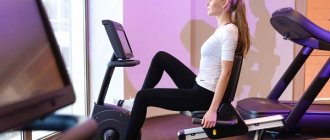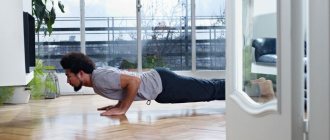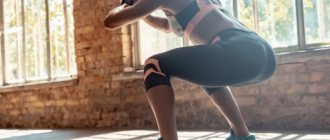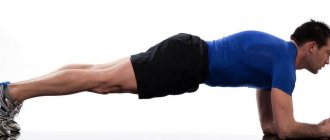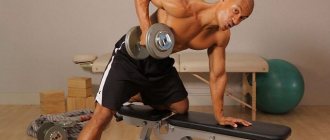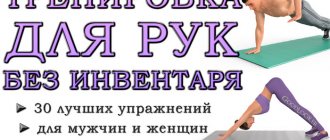All the salads have been eaten, New Year's films have been watched, but you no longer have the strength to lie on the couch? Perhaps it's time to take care of yourself and get back into last year's shape. Even a short workout will help you get rid of those holiday pounds. Together with blogger Arseny Kim
We are talking about 15 one-minute exercises, after which you will definitely feel hot.
Sit well: 5 exercises for home workout with a chair
You don’t need equipment for this cardio, and each exercise needs to be done for one minute.
Side steps with knees raised
Repeat the first exercise. The main thing is not to stop. Throughout the entire workout, the muscles should remain toned.
Effective workout at home with minimal equipment. Leveling up is no worse than in the gym
What is cardio exercise?
Cardio training is a type of physical activity in which the heart works at an increased rate, and the source of energy is subcutaneous fat and glycogen. Loads of this kind have a positive effect on the functioning of organs, strengthen blood vessels, develop the respiratory system, increase endurance and help lose weight.
The training is characterized by a minimal set of strength exercises and, although it involves various muscle groups, does not lead to an increase in muscle mass. This type of load is usually present in any fitness program, but is also quite suitable for training at home. In this case, a necessary condition for effectiveness is increased heart rate values.
Exercise accelerates the heart muscle to the required number of contractions, during which the body activates metabolism and biochemical processes. Maintaining the heart rate within the specified limits for 30-60 minutes ensures a high-quality training result, but exceeding the specified limits already poses a health hazard. Therefore, during the lesson, constant monitoring of the state of the above parameters is necessary.
Knee to palm twice
Place your bent arms in front of your chest with the backs of your palms facing forward. The position is as if holding onto a horizontal bar. Fists at chin level. Raise your left thigh parallel to the floor. Turn your right forearm horizontally, straighten your palm, almost touching your knee. Lower and lift your left thigh toward your palm (keep your forearm in the same position). Repeat for the other side.
All movements are precise: raise your legs to the same height, lower your palm in one firm movement. Keep your back straight.
Rules for performing cardio training at home
If for some reason you can’t regularly go jogging or go to the gym, you can organize cardio training at home. There are general recommendations for conducting such classes. But before you start, you need to undergo a full medical examination to exclude contraindications. Once the doctor's permission has been received, you can start preparing. What to do:
- determine a place in the house for training;
- purchase a special rubberized mat, heart rate monitor or fitness bracelet;
- choose suitable clothes.
As for the training itself:
- It is necessary to ventilate the room before each lesson.
- You should start with simple loads and gradually increase complexity. The first time may be difficult, but after 3-5 workouts the body will adapt.
- There is no need to torture yourself with long exercises. Cardio does not involve prolonged exercise. The optimal time is 40–60 minutes.
- It is advisable to train to music. It motivates and lifts your spirits.
- Warm-up should not be neglected - this is an important stage. You need to finish the session by stretching your muscles. Preparing the joints and warming up the body will help avoid injuries and problems with blood vessels, and a cool-down at the end of the workout will return you to a calm state and speed up the recovery of the body.
- Don't forget about your drinking regime.
- You should breathe correctly: inhale through your nose and exhale through your mouth.
- Heart rate should be kept at 60-80% of the maximum allowable rate. If you don’t have a device, you can measure your pulse manually for 15 seconds and multiply the value by 4.
- Rest periods should not exceed 40 seconds.
- It is better to use an interval mode (30 seconds of work - 15 seconds of rest) - this will allow you to achieve effectiveness in losing weight.
Pulse and cardio: how to calculate individually
The maximum heart rate level for a particular person is calculated using the formula 220 minus age. During the first weeks, the indicator should not be allowed to exceed 60% of the obtained value, and then - 70-80%. An individual heart rate zone is selected depending on the load goals:
| Pulse zone | % of maximum heart rate | Heart rate readings (boundary parameters) | Allowable training time, min | Characteristic |
| Aerobic | 50-60 | 102-112 | 20-40 | Light load, recommended for beginners. Speeds up metabolism and tones the body. |
| Fat burning | 60-75 | 112-133 | 40-80 | Exercises with a low level of muscle load. Recommended for frequent, low-intensity exercise that builds endurance. |
| Strength endurance | 75-85 | 133-151 | 10-40 | A more powerful aerobic workout. Characterized by ease of breathing and muscle fatigue. With a standard duration, it is recommended for everyone. |
Nutrition
Cardio training is pointless if you do not combine physical activity with proper nutrition. Even before starting classes, you need to review your diet and, whenever possible, give preference to healthy foods.
An hour before classes, you can eat light proteins (yogurt, lean meat and cottage cheese, eggs) and carbohydrates with a low glycemic index (whole grain cereals and wholemeal products, vegetables, brown rice). After exercise, you should pay attention to protein foods.
How and when is the best time to practice?
The standard workout duration for weight loss is 40-60 minutes. Fat begins to be consumed after half an hour, so you shouldn’t stop. However, cardio exercises after strength training should not exceed 20-30 minutes, and the same applies to the morning hours on an empty stomach - no more than half an hour. Both options will use fat as fuel because glycogen levels are reduced. The regularity of weight loss exercises is 2-3 times a week.
Although you can exercise at any time, the timing depends on the chosen type of cardio, equipment and exercise equipment:
- Morning. This period is more suitable for running, walking and cardio exercise. Classes are held on an empty stomach. After a night on an empty stomach, fat is burned instantly, so you can devote 30 minutes to exercise. But it is better not to do interval and strength training, as well as exercises with weights.
- Day. This time can be devoted to any type of cardio. Conducted in the afternoon, they strengthen the heart rather than contribute to weight loss. The lesson should last 1 hour. After training, it is necessary to “feed” the body with protein foods (after 30-45 minutes). An hour after eating, you can eat complex carbohydrates.
- Evening. It is also suitable for any cardio exercise and does not differ in duration from daily exercise. Whether a workout will burn fat depends on what you eat before the workout. To lose weight, it is important to maintain an interval of 1.5-2 hours. To avoid accumulating fat at night, the menu should include protein and vegetables.
- Morning and evening - double cardio. This option is used for fat burning, and it works great. Morning and evening workouts should take 30 minutes each. The first is performed on an empty stomach, and the second before bedtime, without consuming anything afterwards.
Proper clothes and shoes
The material from which workout clothing is made should be moisture-wicking and breathable. If activities involve increased sweating, it is better not to choose cotton fabrics, but to purchase products with antibacterial impregnation. Often girls wear smaller suits, but this is unacceptable. Clothing must match your figure to make the suit comfortable. You should also pay attention to the seams: they should be soft.
As for shoes, only sneakers are suitable for classes, not sneakers, socks, etc. You should also not exercise barefoot. Choosing the wrong shoes can lead to injuries or joint problems. It is better that the sole springs well and does not slip, and there are ventilating inserts on the sides. In addition, sneakers should support the arch of the foot and fit snugly on the foot.
How to do cardio for weight loss
It is worth noting that cardio training does not always lead to burning a large number of calories. Especially if the lesson is organized incorrectly. In addition, too intense and prolonged exercise can lead to wear and tear on the heart. That is why it is important to correctly calculate your resources and draw up an activity plan.
Different people have different rates of burning fat deposits. The indicator depends, in particular, on age, degree of exertion and physical condition. In general, to get good weight loss results, the training rhythm should keep your heart rate as high as possible (70-80%). This pace allows you to burn about 500-800 kcal in 1 hour. But when the values are exceeded, fat burning, oddly enough, stops.
In any case, cardio for weight loss is chosen in accordance with individual characteristics and goals. Start training at a minimum pace and increase your heart rate gradually, controlling its values. Running is considered an effective and popular exercise option. But such activity is not suitable for overweight people due to the high pressure on joints and knees. Other fairly effective options include swimming and jumping rope.
List of mistakes that are best avoided when doing cardio for weight loss:
- Less than 20 min workout. The body simply does not have time to start burning fat. The exception is cardio exercise on an empty stomach.
- A load that lasts more than an hour. The body becomes overtired, the heart works overtime, and fat is not lost
- Low heart rate. Such an activity, no matter how long it lasts, only leads to an improvement in well-being.
- Increased heart rate. Loads work to wear out the heart, not to burn fat.
The benefits of cardio training
In addition to burning calories and increasing endurance, cardio exercises:
- ventilate the lungs and saturate the body cells with oxygen;
- train the heart muscle, reducing the risk of heart attack;
- act as a prevention of atherosclerosis, hypertension and diabetes;
- speed up metabolism;
- normalize hormonal levels and improve skin condition;
- reduce the level of “bad” cholesterol;
- strengthen bone tissue;
- promote the production of endorphins, which increases the body's resistance to stress;
- normalize the activity of the central nervous system;
- They tone up overall and increase energy.
The success and benefits of any type of cardio training depend on proper nutrition. Only a diet with a large amount of complex carbohydrates and protein will help maintain strength, energy and normalize the functioning of all body systems. Such loads are recommended for several categories of the population at once. Thus, moderate cardio exercises help older people maintain the condition of the heart and blood vessels and prolong the years of active life. Combining cardio and strength training allows overweight trainees to get the body of their dreams. In addition, cardio helps develop endurance during cyclic sports and allows you to recover from intense exercise and overtraining.
By the way!
Some experts recommend equipping a mini-gym at home: take a small treadmill, if space allows, or an exercise bike. A stepper will also work. With their help, you can walk at home, staying in one place, and get the required level of activity.
The recommendations also include various family games that can replace a walk down the street. For example, “An Extra Chair” helps to relieve tension and get everyone involved and active.
In addition, you can subscribe to competent fitness trainers and do exercises with them. By the way, there are also those trainers who practice marching walking and other variants of stepping disciplines.
Running or walking? What to choose for health Read more
Fat burning workout without jumping and running: a set of exercises
At first, take your time: perform the exercises at your own pace, even if in the 20 seconds allotted for each movement, you will not have time to do so many repetitions - it is important to master the correct technique. On the 3-4th workout, it makes sense to increase the speed of movement by performing more repetitions in 20 seconds.
Swing your legs
1-swing
Stand straight, place your feet shoulder-width apart. Transfer maximum body weight to your right foot, move your left foot to the side and lift it to the level of the pelvis, spread your arms to the sides. Work the muscles of your legs, abs, buttocks and arms. Then lower your left leg to the floor, transfer your body weight to your left foot and lift your right leg to the right. Return to the starting position. This will amount to one repetition. Complete the required number of them.
Leg raise with rotation
2-leg raise with rotation
Stand straight, place your feet shoulder-width apart. Stretch your arms up. Place your maximum body weight on your right foot, bend your left knee and pull it towards your stomach. At the same time, lower your arms down to the sides of your left foot. Work the muscles of your legs, abs, buttocks and arms. Then place both feet on the floor, extend your arms up, transfer your body weight to your left foot, bend your right knee and pull it towards your stomach. Place your hands on the sides of your right foot. This will amount to one repetition. Complete the required number of them.
Bent over crunches
3-bending crunches
Stand straight, place your feet hip-width apart. Smoothly move your pelvis back and lean your body forward, bend your knees slightly. Stretch your arms to the sides. Smoothly twist your body to the left, trying to touch the floor with your right palm. Work your abdominal, back and arm muscles. Then twist your body to the left, touching the floor with your left palm. This will amount to one repetition. Complete the required number of them.
Tilts
4-tilts
Stand straight, feet hip-width apart. Stretch your arms up. Lean your body forward and step back slightly with your left foot. Work the muscles of your abs, back, legs and arms. Do not increase the arch in your lower back. Then return to the starting position. After this, smoothly lean forward, stretching your arms, and step back with your right foot. Return to the starting position. This will amount to one repetition.
Lunge Bends
5-bends with lunge
Stand straight, feet hip-width apart. Stretch your arms up. Lean your body forward while stepping back with your left foot. Then straighten up, continuing to stretch your arms up, and step your left foot forward, bending your knees slightly. This will amount to one repetition. Perform the required number of them in each direction.
"Climber"
6-climber
Take a lying position, leaning on straight arms and toes. Do not increase the arch in the lower back, work the muscles of the abs, back, arms and legs. Bend your left knee and pull it towards your stomach. Then return to the starting position, bend your right knee and pull it towards your stomach. This will amount to one repetition, complete the required number of repetitions.
Lifting and turning legs
7-lifting and turning the legs
Lie on your right side, extend your right arm behind your head. Place your left palm on the floor in front of you at stomach level, lean on it. Bend your legs slightly. Fix the right one on the floor. Lift your left one (without straightening) up and turn your knee towards the ceiling, with your toe stretching away from you. Return to the starting position. This will amount to one repetition, perform the required number in each direction.
Swing your legs while lying down
8-leg swings lying down
Lie on your right side, extend your right arm behind your head. Place your left palm on the floor in front of you at stomach level, lean on it. Legs straight, toes pulled towards you. The pelvis is fixed, the lower back is stable, the stomach is tucked. Smoothly lift your left leg as high as possible, then lower it onto your right. This will amount to one repetition. Do the required amount in each direction.
Diagonal crunches
9-diagonal crunches
Lie on your right side, place your left hand behind your head. Rest your right palm on the floor. Working the muscles of your legs and abs, simultaneously lift your legs and body above the floor. Then slowly lower yourself to the floor. This will amount to one repetition. Complete the required number of them.
Leg spin
10-leg rotation
Lie on your back, stretch your arms along your body. Bend your knees, place your feet on the floor. Lift your right leg off the mat and, keeping your knee slightly bent, rotate it clockwise at the hip joint. Describe one circle - this will make one repetition. Do the required amount in each direction.
Do this program regularly and, if possible, supplement your workouts with other types of cardio you are allowed (Nordic walking, swimming). You will be able to see the first results within a month.
Is it worth taking weights?
You can also use weights, such as water bottles, if you really want to. However, this is not necessary, and in some cases it is harmful. Excess weight can cause muscle spasms or overload the spine. Roughly speaking, the weights should be below the waist, i.e., in the case of walking, on the ankles, but if you don’t tie water bottles to them, it will be inconvenient.
You should be more careful when suggesting that you take a backpack, load it with bottles of water or something else, and walk around like that. Here you can simply sit on your back.
Many people appeal to the fact that no one gets their back hurt from their backpacks when hiking. The risk of getting a spasm of something in this situation is explained simply. A man with a backpack on a hike walks on an uneven surface, and where the ground is uneven, there are different voltage vectors, as a result of which overload does not occur. At home, a perfectly flat floor, which is basically harmful. And it is not recommended to walk on it a lot. You can only walk around the house carefully and very softly, under no circumstances walking on your heels; it is better to use cat running, like a ballet, on your toes. But even with this method of movement, you should be careful, because with prolonged exercise the calf muscle will be pumped too much. If you walk on your toes for an hour, you can overstretch it and damage your Achilles tendon.
“Two hours of walking - plus seven years of life.” Doctor on preventing heart disease Read more
Knee joints during exercise: the dangers of jumping and running
These types of activities involve impact on the knees and spinal joints. “Although the foot and ankle bear the brunt of the stress, the knees are the most commonly injured during running,” writes Stephen Barrer, an American neurosurgeon and author of the best-selling book Sports Beware! About the dangers of running, fitness and other physical activities .
- Why? They receive an enormous load, especially if you have flat feet and your feet are not able to fully absorb shock.” This is why many fitness professionals complain about pain and discomfort in their knee joints. “Knee pain is one of the most common injuries among fitness enthusiasts. Whether it’s running, squats, jumping or other activity, the load on the knees is carried out with every step we take, notes Natalya Ermakova, gym instructor at the World Gym Club - Irkutsk . “The less shock absorption, the greater the chance of missing the next workout, or even damaging the joint.”

